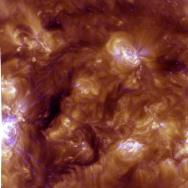An international team of scientists using the Gemini Observatory telescope in Chile has found a way to measure the amount of both water and carbon monoxide in the atmosphere of a planet in another solar system, roughly 340 light years away.
This is the first time scientists have been able to measure the actual amounts of molecules in the atmosphere of such a distant planet, and they hope the technique will be a significant leap forward in our understanding of planets in other solar systems—including how they form and where to look for signs of life.
“This opens up a whole new window into planetary atmospheres,” said study co-author Jacob Bean, an associate professor of astronomy and astrophysics at the University of Chicago. “Previously we could tell whether there were certain molecules, but not how many, and that makes a huge difference. It’s like being able to see the entire iceberg, not just what’s above water.”
The team—led by Michael Line, an assistant professor at Arizona State University’s School of Earth and Space Exploration—published its findings Oct. 27 in the journal Nature.
Faint, faraway and fascinating
We now know there are thousands of planets outside of our own solar system, which are called exoplanets. But it took scientists so long to start seeing them because they’re incredibly far away and hard to see next to the blinding light of their stars. It’s only thanks to better telescopes and techniques in the past two decades that we’ve been able to find them at all, and the field is still evolving rapidly.
Because they’re so faint, scientists only have a few ways to tease out clues about what these planets actually look like. One of them is by looking for what molecules exist in these planets’ atmospheres. That can hint at what the planet’s surface probably looks like, how it formed, and even what might live there.
For example, alien astronomers would probably be able to find us by the amount of oxygen in our atmosphere, which you wouldn’t expect to see based on Earth’s geologic makeup—because it was put there by plants.
Previously, scientists could use instruments like the Hubble Space Telescope to get a preliminary sense of a planet’s atmosphere and whether or not it contains elements like oxygen or carbon. But they didn’t know how many atoms of those elements there were. “Knowing the abundance of an element—not just whether it’s present or not—makes a huge, huge difference in recreating scenarios of how a planet formed and what it looks like now,” said Bean.
So the team wanted to try to find out if they could use recent advances in processing techniques to pick out the abundances of the primary molecules that are made up of carbon and oxygen atoms.
They focused on a planet known as “WASP-77Ab,” a type of exoplanet called a “hot Jupiter” because they are like our solar system’s Jupiter, but roughly 20 times hotter.
“Because of their sizes and temperatures, hot Jupiters are excellent laboratories for measuring atmospheric gases and testing our planet formation theories,” said Line.
Because observing time on space-based telescopes, like Hubble, is very hard to get due to demand from astronomers all around the world, and because Hubble can’t measure all the important molecules, the research team wanted to find out if they could use a ground-based telescope instead. There are many more telescopes available on Earth than in space, but until now it’s been hard to use them for measuring atmospheric properties on other planets because Earth’s own atmosphere gets in the way and scrambles the readings. But the team hoped to use recent breakthroughs in data processing to pick out what they needed.
They turned to Gemini South, an 8.1-meter-diameter telescope located on a mountain in the Chilean Andes, operated by the National Science Foundation’s National Optical-Infrared Astronomy Research Laboratory (NOIRlab). At the telescope, with an instrument called the Immersion GRating INfrared Spectrometer (IGRINS), the team observed the thermal glow of the exoplanet as it orbited its host star.
From this data, they were able to get clear measurements of both water and carbon monoxide in the atmosphere of WASP-77Ab based on the wavelengths of light they observed from the planet. The readings ran close to what they expected based on simulations and models, but with some subtle differences that will take time to analyze, the scientists said.
They hope to confirm the readings against data by the James Webb Space Telescope, the powerful new successor to the Hubble Space Telescope, which NASA is scheduled to launch later this year.
If they are confirmed, the team hopes the new method used in this study will be able to give them complementary information that would be difficult for even more powerful telescopes like Webb to get.
“We think we’ll be able to use this technique to get the abundances of the different isotopes of elements, which is a very powerful source of information,” Bean said. “Different processes and conditions in planetary systems will leave fingerprints in the isotopes—it could tell us a lot about how exoplanets form and evolve.
“If you’d told me 10 years ago we’d be able to use a ground-based telescope to get this kind of data, I’d definitely have said you were crazy,” he said.
What Line and the team expect to do next is repeat this analysis for many more planets and build up a library of atmospheric measurements from at least 15 more planets. Study co-author and former UChicago graduate student Megan Mansfield, PhD’21, now with the University of Arizona, is working on a larger survey of planets with the same technique.
They also look forward to what future telescopes will be able to offer.
“If we can do this with today’s technology, think about what we will be able to do with the up-and-coming telescopes like the Giant Magellan Telescope,” said Line. “It is a real possibility that we can use this same method by the end of this decade to sniff out potential signatures of life, which also contain carbon and oxygen, on rocky Earth-like planets beyond our own solar system.”
The research team also includes Joseph Zalesky, Evgenya Shkolnik, Jennifer Patience, and Peter Smith of ASU’s School of Earth and Space Exploration; Matteo Brogi and Siddharth Gandhi of the University of Warwick (UK); Vivien Parmentier and Joost Wardenier of the University of Oxford (UK); Gregory Mace of the University of Texas at Austin; Eliza Kempton of the University of Maryland; Jonathan Fortney of the University of California, Santa Cruz; Emily Rauscher of the University of Michigan; and Jean-Michel Désert of the University of Amsterdam.
Citation: "A solar C/O and sub-solar metallicity in a hot Jupiter atmosphere." Line et al., Nature, Oct. 27, 2021.
Funding: NASA, UK Science and Technology Facilities Council, Heising-Simons Foundation, Wolfson Harrison UK Research Council, Mt. Cuba Astronomical Foundation, U.S. National Science Foundation, MacDonald Observatory, Korean GMT Project of KASI, Gemini Observatory.

